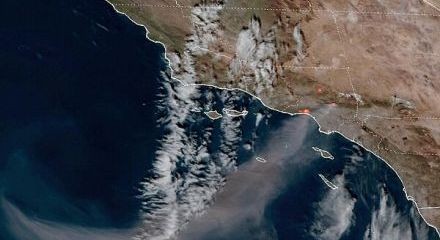16.01.2025

Atmospheric blow-dryer
Danny Hammill argues that the LA wildfires have been made hellishly worse by urban sprawl, budget cuts and, most of all, global warming
Los Angeles and parts of Ventura county to the north are experiencing yet another “particularly dangerous situation” (or PDS), due to the Santa Ana winds, which have gusts of up to 75mph or more.1 This particular designation is meant to signal “the extreme of extremes” and was first used in the 1980s to alert people to tornado outbreaks in the Midwest, and some meteorologists want to expand PDS warnings to include disasters such as ice storms, floods, hurricanes, and now wildfires. Revealing the severity of the crisis, this is the fourth time in recent months that LA has faced PDS warnings, all of which resulted in major wildfires.
Southern California’s winds typically flow onshore from the Pacific, carrying moist air onto land, but the Santa Ana winds are currents that move in the opposite direction and typically occur from September through May. These very dry winds help to explain the catastrophic nature of the fires in regions that have been without significant rain for many months. They act as an “atmospheric blow-dryer” for vegetation. In a connected phenomenon, embers have helped spread the fires. Whilst you might think otherwise from looking at the endless apocalyptic images coming from California that instantly conjure up memories of Hollywood disaster movies, in fact most homes destroyed by the wildfires are not overcome by a racing wall of flames, but burn after being ignited by airborne embers - firebrands - that range in size from tiny specks to larger chunks and can travel for miles. A single ember that falls on the ground can burn out within minutes; but it might smoulder and a sudden wind gust has the potential to cause a lot of destruction by reigniting it. It is often the neighbourhoods that are closer to the wildlands that get inundated with embers, the winds allowing them to burn harder and release more energy - becoming a more potent ignition source. Firebrands can gather between the slats of wood fences, for example, or in shrubbery, and start new fires as they accumulate and the winds change direction.
Evacuations
Firefighting crews not only from California but also nine other states are rushing to the area as part of the response - we shall see whether that is sufficient. As of January 14, over 84,000 people had been warned they might be ordered to evacuate because of fire risk, while another 88,000 remained under current evacuation orders. So far, though unfortunately the number is almost bound to increase, 25 people have died from the fires and more than 12,000 structures have been destroyed.
Some estimates put the damage at about $250 billion, making it the costliest fire in American history, and it could also become the costliest ever in terms of insured losses of possibly up to $20 billion. Alas. this is very likely to spell another disaster, as it may also lead to higher homeowners’ insurance costs, if they can get insurance at all. Though space considerations preclude a detailed discussion here of the insurance nightmare facing many Americans, thousands of policy holders in Pacific Palisades in July were dropped by their insurers, State Farm. Remember, the Palisades is an area associated with the wealthy elite, such as A-list celebrities, actors, directors, etc.2
While the authorities do not know yet what sparked the deadly fires - some suggesting arson, without seeming to have any real evidence - there is a hunt for someone to blame, especially from the right. Donald Trump, of course, has blamed the Democrats - whether at the state or federal level - for the “mismanagement” of water, without telling us what he would have done differently. The Independent Institute, a far-right libertarian group based in California, blames the state government there for not having a purely privatised fire service that apparently would have been more careful with the availability and expenditure of water - a ludicrous notion, when quite the opposite is true.
Grotesquely, far-right ‘influencers’ and the likes of Elon Musk - who unfortunately has an opinion on everything these days - have used the wildfires as an opportunity to continue their attacks on diversity, equity and inclusion policies (DEI). The billionaire circulated screenshots on X of the Los Angeles Fire Department’s four-year-old ‘racial equity action plan,’ writing that “they prioritised DEI over saving lives and homes” - though it remained unexplained how this was the case, but it was a classic exercise in dog-whistle politics. Kristin Crowley, the city’s fire chief, is the first woman and openly gay person in that role - meaning that she and the city fire department immediately became targets in the rightwing media. Charlie Kirk, founder of the Trump-aligned non-profit organisation, Turning Point USA, ranted on his podcast about how the wildfires show what happens “when you focus your government on diversity, equity, inclusion, LGBTQ pet projects, and you are captured by environmentalists” - it means you are too “worried about abstractions” to “do the basic stuff”.
Inevitably, there has been a furious debate about whether there have been cuts or not to the LAFD budget in 2024-25, and the general performance of Karen Brass, the Democratic mayor of LA since 2022. The governor of California, Gavin Newsom, has ordered an investigation into the city’s Department of Water and Power over the loss of water pressure and there is an online petition demanding Bass’s immediate resignation that has gathered support from a wide spectrum of political opinion.3 Elon Musk, of course, called the mayor “utterly incompetent” on X, but her defenders say that this year’s much smaller budget compared to the previous year should not be described as a “cut” because the LAFD got a budgetary boost to deal with particular expenses the year before. The LAFD was clearly understaffed and not for nothing did Kristin Crowley warn, in a letter published on December 4, that these cuts had “severely limited the department’s capacity to prepare for, train for and respond to large-scale emergencies, including wildfires”.
Meanwhile, the rightwing New York Post said the LA fire department had suffered cuts in their budget because too much was being spent on homeless services - an extraordinarily insensitive statement, given that so many residents had just become homeless overnight themselves - though the more moderate The Intercept said budget cuts were actually linked to extra funding for the police. Take your pick, because at the end of the day that money is fungible. At the same time, the middle classes in Los Angeles are beginning to blame the ultra-rich who have been disregarding the controls on water use through using sprinklers to keep their lawns green and making sure that their magnificent high-status swimming pools are still usable, and so on and so forth, with the result that there is not enough water available in the reservoirs for fighting the fires. You can understand their grievances.
There are other factors at play, of course, like the role played by private energy monopolies, such as California’s Pacific Gas and Electric, and the state government’s failure to regulate it properly. Then there is the crazy level of house-building in the area that has been totally unplanned: dry brush, steep hillsides, high winds and packed timber buildings all combined amounts to a disaster waiting to happen. Environmental activists have warned for decades about the obvious risks of living in hillside neighbourhoods like Pacific Palisades - which has been largely incinerated and might never be rebuilt, especially if it is impossible to get insurance.
Unusually dry
But there can be no doubt that the LA fires were made hellishly worse by global warming. Hence we have had an unusually dry December and January in California, hugely increasing fire risk. Equally, there is a shortage of water, which to a considerable extent can be attributed to the drying out across the western United States as a result of the melting of the snowpack on the Rockies. In the same way, there are problems with water supplies in continental Europe as a result of retreating glaciers and all the rest of it. Donald Trump, of course, wants to “drill, baby, drill” and it is likely that various forms of sanctions and protectionism will be directed against anybody who wants to do climate mitigation activities of one sort or another.
Not exactly in a hurry, it appears, the president-elect has been engaged in talks about a visit to survey the damage in LA, which is almost enemy territory. Thus he has wittily called the Californian governor “Gavin Newscum” and bizarrely claimed that he “refused to sign the water restoration declaration put before him” - a declaration that does not exist - because “he wanted to protect an essentially useless fish called the smelt”.4 This small fish (hypomesus transpacificus), once abundant a few decades ago, has almost disappeared in the 2010s due to massive water pumping in the fight against drought. Hardly a concern for climate denialists like Trump, who wants to continue supplying water to farmers regardless of the environmental consequences.
Joe Biden said last week that he prays the Trump administration continues the focus on the federal response to the deadly wildfires. But he could be disappointed, seeing how the House Speaker, Mike Johnson, believes that there should be “conditions” on disaster aid sent to California, as state and local leaders “were derelict in their duty”. He has not spelled out what those conditions are, but has admitted there have been conversations about tying a debt ceiling raise to the aid.
Positive
On a more positive note, it is encouraging that the wildfires have prompted people to rediscover the writings of Mike Davis, especially his brilliant 1998 work, Ecology of fear. But we should not forget his equally great works like City of quartz: excavating the future in Los Angeles or Dead cities, and other tales. He was a prominent figure in the now defunct International Socialist Organisation, the Cliffite group in the US that voted to dissolve itself in 2019.
What we should particularly remember about Ecology of fear is Davis’s passionate argument for a far greater degree of planned housing in LA to minimise the dangers posed by the “lethal combination of homeowners and brush” that appeared in a chapter provocatively entitled, “The case for letting Malibu burn”. Discussing the Kinneloa Fire five years earlier,5 the comrade stated that “the conflagrations of 1993 came down grimly familiar pathways” with “no shortage of omens” - the fires driven by a combination of extremely dry and flammable vegetation, strong Santa Ana winds, and rugged topography. Sound familiar? Twenty years later, Davis wrote that too much new housing in California had been built “profitably but insanely, in high-fire-risk areas” - areas that fire experts call “the wildland-urban interface”.
Another great writer frequently mentioned in this context is Joan Didion and her 1968 essay about the Santa Ana winds that appeared in the highly recommended collection Slouching towards Bethlehem.6 She writes about LA weather being “the weather of catastrophe, of apocalypse” and “the violence and the unpredictability of the Santa Ana affect the entire quality of life in Los Angeles, accentuate its impermanence, its unreliability”. The winds “show us how close to the edge we are”.
-
apnews.com/article/california-wildfires-pds-warning-los-angeles-f38e97513c7a01f9ce13cb7f49122cda.↩︎
-
cbsnews.com/news/fires-california-palisades-fire-homeowners-insurance-state-farm-fair-losses.↩︎
-
change.org/p/demand-the-immediate-resignation-of-mayor-karen-bass.↩︎
-
www.murrieta.k12.ca.us/cms/lib5/CA01000508/Centricity/Domain/1538/The%20Santa%20Anas.pdf.↩︎
